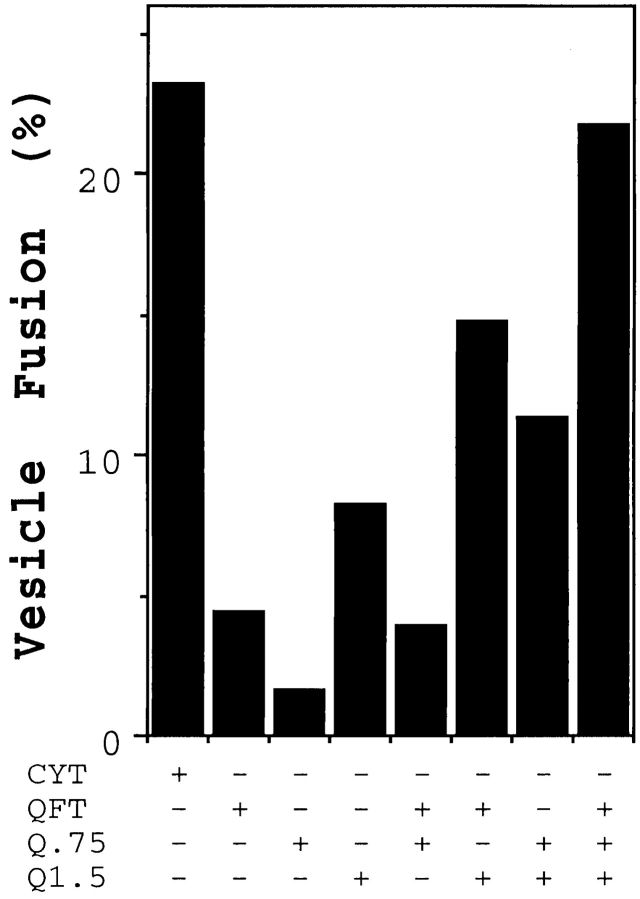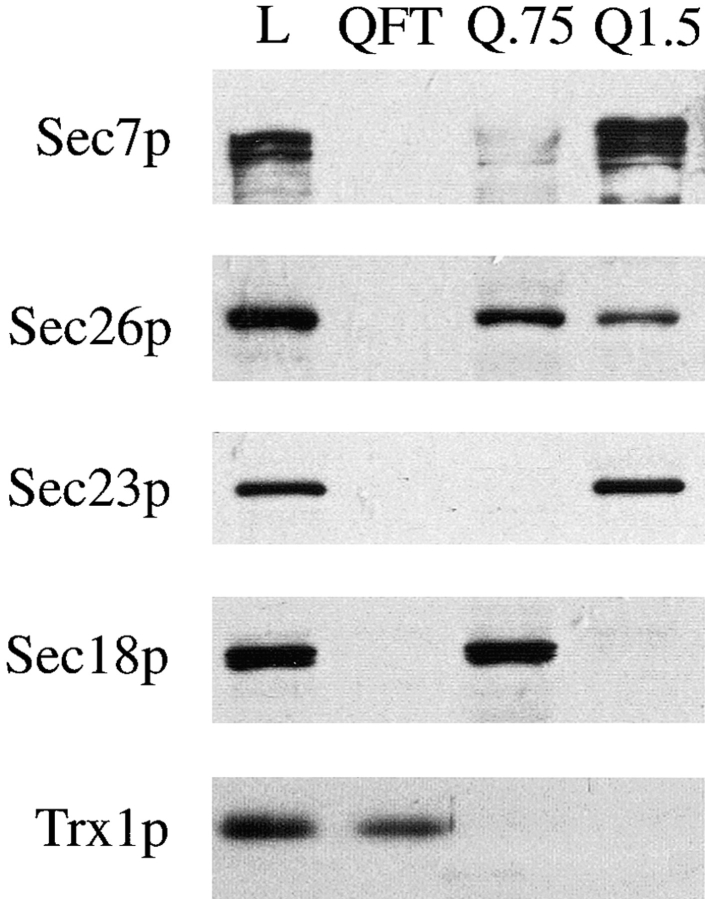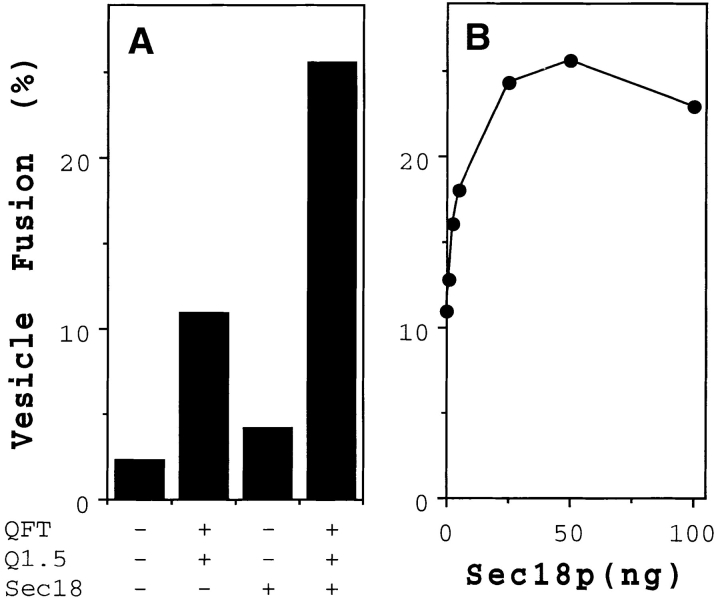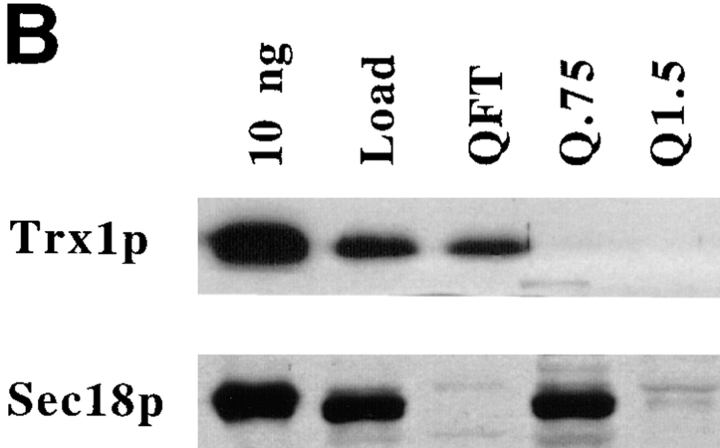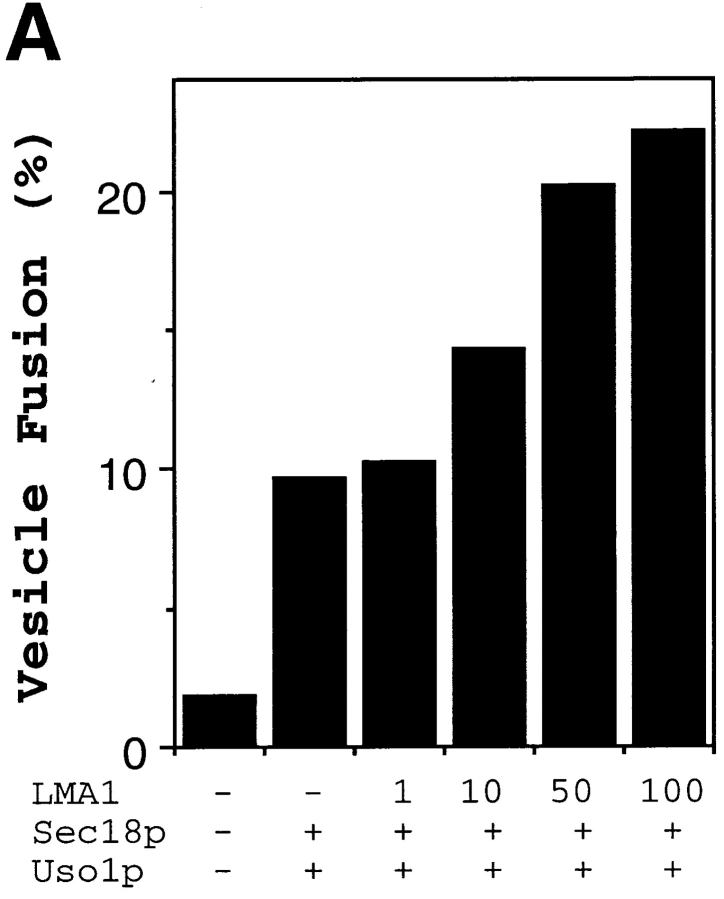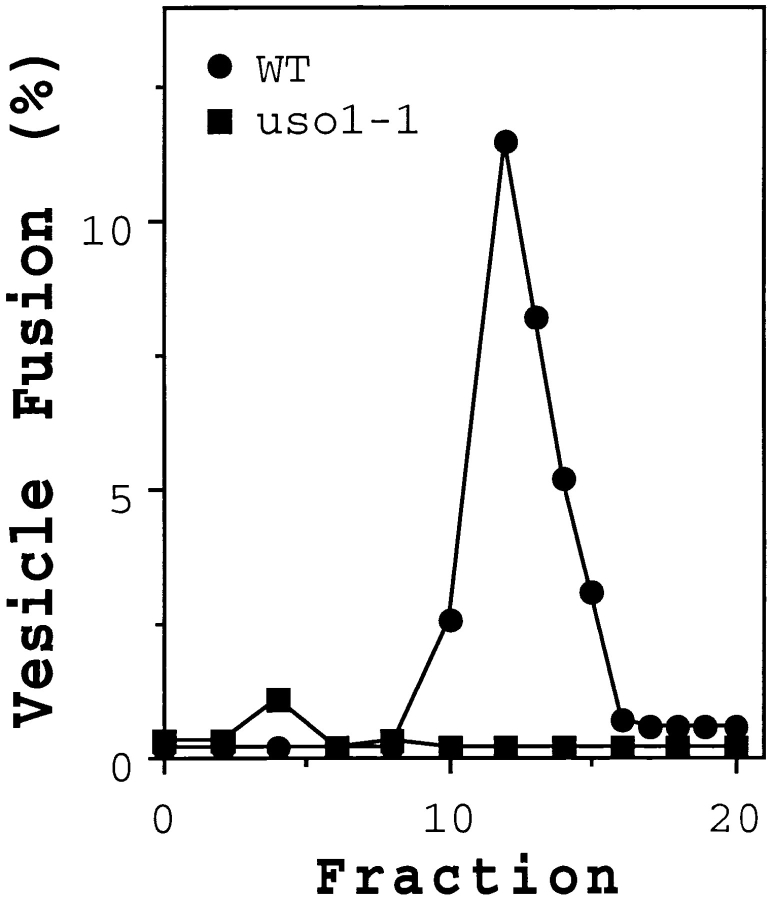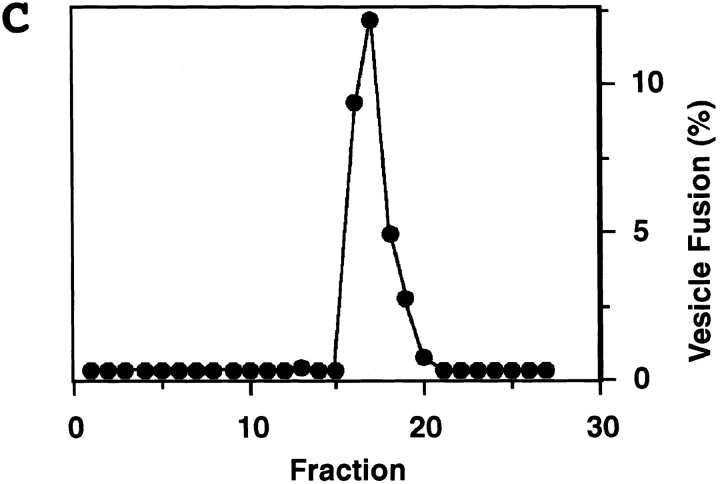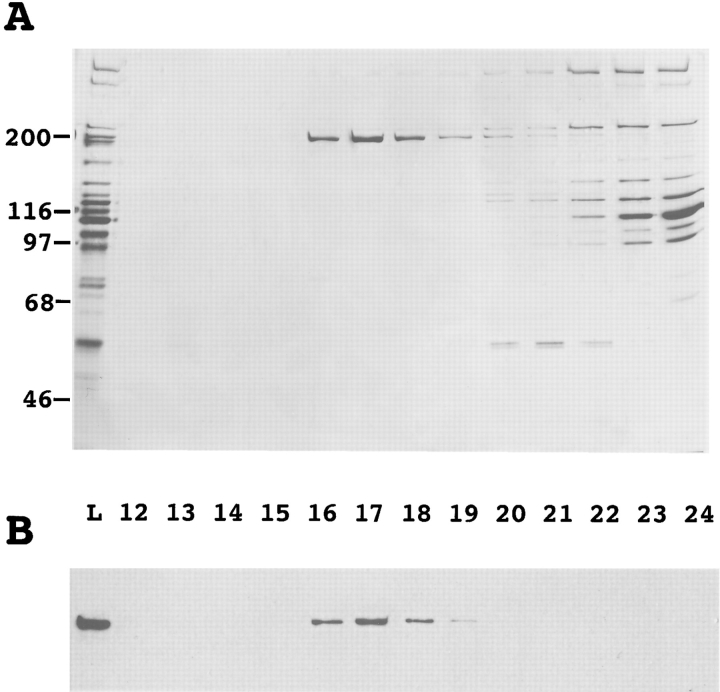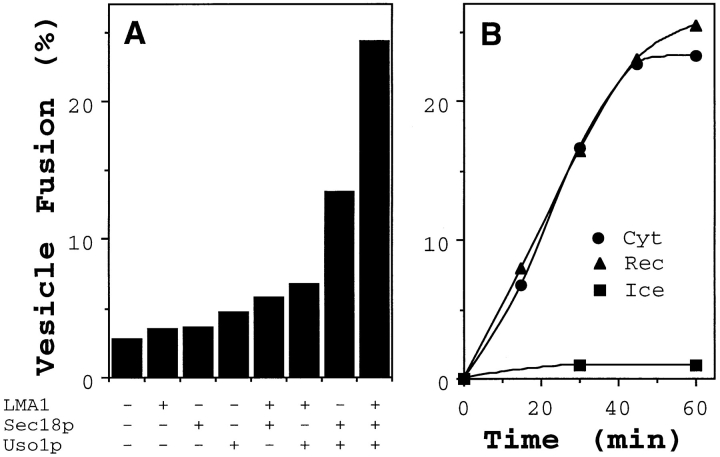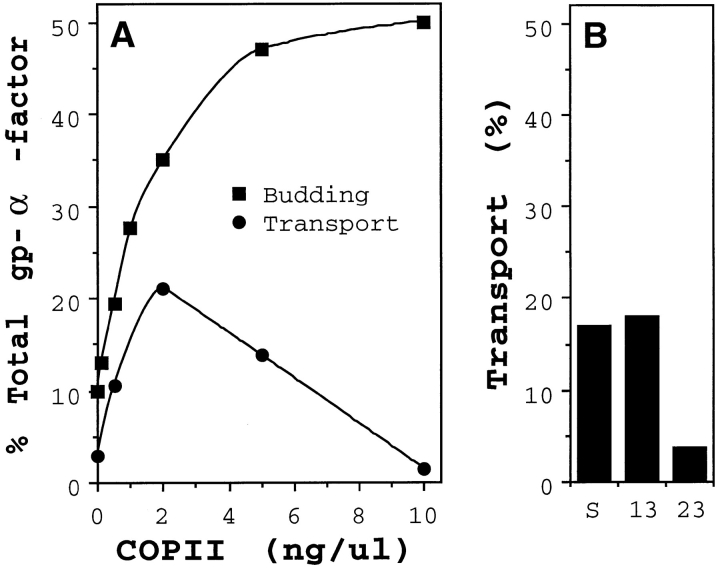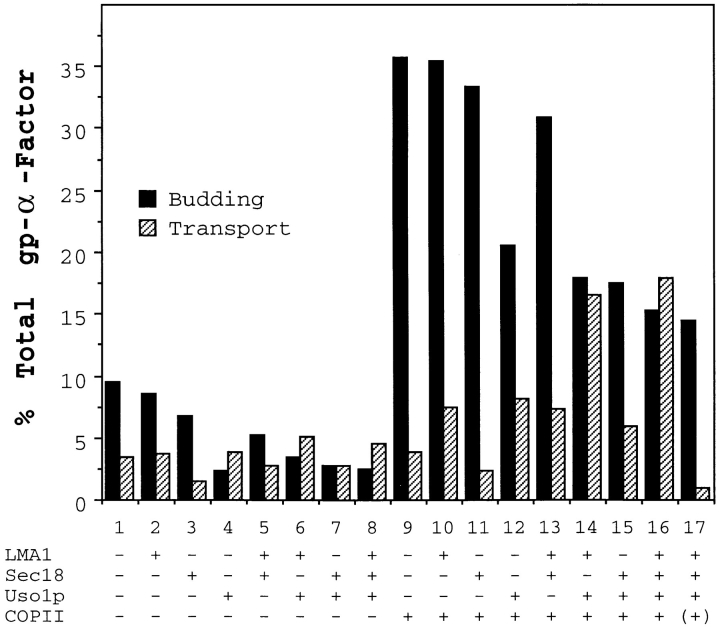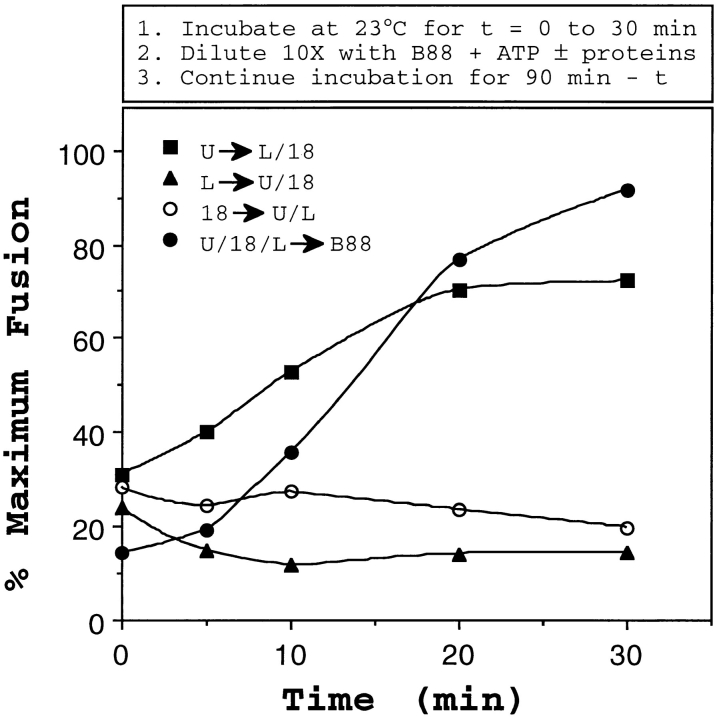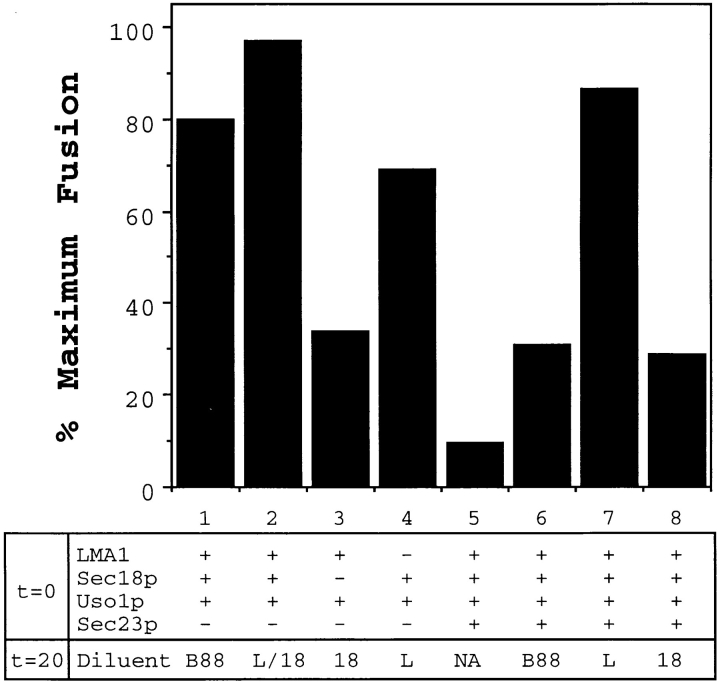Abstract
A cell-free vesicle fusion assay that reproduces a subreaction in transport of pro-α-factor from the ER to the Golgi complex has been used to fractionate yeast cytosol. Purified Sec18p, Uso1p, and LMA1 in the presence of ATP and GTP satisfies the requirement for cytosol in fusion of ER-derived vesicles with Golgi membranes. Although these purified factors are sufficient for vesicle docking and fusion, overall ER to Golgi transport in yeast semi-intact cells depends on COPII proteins (components of a membrane coat that drive vesicle budding from the ER). Thus, membrane fusion is coupled to vesicle formation in ER to Golgi transport even in the presence of saturating levels of purified fusion factors. Manipulation of the semi-intact cell assay is used to distinguish freely diffusible ER- derived vesicles containing pro-α-factor from docked vesicles and from fused vesicles. Uso1p mediates vesicle docking and produces a dilution resistant intermediate. Sec18p and LMA1 are not required for the docking phase, but are required for efficient fusion of ER- derived vesicles with the Golgi complex. Surprisingly, elevated levels of Sec23p complex (a subunit of the COPII coat) prevent vesicle fusion in a reversible manner, but do not interfere with vesicle docking. Ordering experiments using the dilution resistant intermediate and reversible Sec23p complex inhibition indicate Sec18p action is required before LMA1 function.
In eukaryotic cells, transport between many distinct membrane-bound compartments proceeds through a vesicular intermediate that buds from one membrane and fuses selectively with another. A framework for this transport process has emerged whereby soluble coat proteins are recruited to the donor membrane forming vesicles that uncoat before fusion with an acceptor compartment (Rothman, 1994). With respect to the membrane fusion step, a set of general factors including N-ethylmaleimide–sensitive fusion protein (NSF)1 and soluble NSF attachment protein (SNAP) are required at many intracellular compartments (Block et al., 1988; Eakle et al., 1988; Clary and Rothman, 1990; Clary et al., 1990). These general factors are used in concert with compartment specific factors such as v/t-SNAP receptors (SNAREs) and small GTPases that appear to be structurally related, yet impart specificity in membrane docking and fusion. The basic mechanisms of intracellular membrane fusion appear to be conserved within a species and from yeast to mammals (for review see Pfeffer, 1996). Although several of the molecules that catalyze specific intracellular membrane fusion reactions have been identified through biochemical and genetic approaches, a molecular description of this process is incomplete.
Using the yeast Saccharomyces cerevisiae as a model eukaryote for the investigation of intracellular transport, a cell-free assay that faithfully reproduces ER to Golgi transport has been developed based on the well-characterized processing and maturation of pro-α-factor, the precursor of a secreted pheromone in yeast (Baker et al., 1988). The application of an in vitro transport assay, together with genetic analyses of sec mutant strains has allowed the division of ER to Golgi transport into three distinct steps: vesicle budding, vesicle targeting, and membrane fusion (Kaiser and Schekman, 1991; Rexach and Schekman, 1991). The first step in this sequence, vesicle budding, has been reconstituted in vitro with a set of soluble factors (Sar1p, Sec23p complex, and Sec13p complex) that collectively form a membrane coat that drives budding from the ER. The vesicles formed with these purified protein fractions, termed COPII-coated vesicles, are competent for fusion with the Golgi apparatus in a reaction that requires cytosol and ATP (Barlowe et al., 1994). This cytosol provides multiple protein components required for fusion, some of which are defined by known secretion defective mutants (Lupashin et al., 1996).
To characterize the molecular events associated with intracellular membrane fusion, the long-term goal is to reconstitute this event with a minimal set of membrane bound and soluble proteins. In this report, the soluble factors required for cell-free docking and fusion of ER- derived vesicles to the Golgi complex have been defined. This vesicle fusion reaction in the presence of ATP and GTP requires purified Sec18p, Uso1p, and a protein complex referred to as LMA1, a heterodimer composed of thioredoxin and IB2 (Xu and Wickner, 1996; Xu et al., 1997). Although these purified factors are sufficient for vesicle targeting and fusion to the Golgi complex, overall ER to Golgi transport in yeast semi-intact cells is dependent on the addition of COPII proteins. Thus, six purified, soluble proteins are shown to catalyze anterograde ER to Golgi transport and are ordered in distinct steps of vesicle budding, docking, and fusion.
Materials and Methods
Strains and Reagents
Strains RSY607 (MATα leu2-3,112 ura3-52 pep4::URA3), RSY919 (MATα ura3-1 mnn1 mnn2), RSY949 (MATα lys2-801 trp1 ura3-52 uso1-1), CBY300 (MATα his3Δ200 leu2Δ1, lys2Δ202 ura3-52 trp1Δ63 uso1-1), and CBY324 (MATα his3Δ200 leu2Δ1, lys2Δ202 ura3-52 trp1Δ63 uso1-1 pUSO1-Myc) were used in these studies. Rabbit antiserum specific for α-1,6-mannose linkages was prepared by intravenous injection of heat-treated RSY919 cells as previously described (Ballou, 1970). Antibodies directed against Sec7p (Franzusoff et al., 1991), Sec13p (Salama et al., 1993), Sec18p (Haas and Wickner, 1996), Sec19p (Haas et al., 1995), Sec23p (Hicke and Schekman, 1989), Sec26p (Duden et al., 1995), Trx1p (kindly provided by Z. Xu, Dartmouth Medical School, Hanover, NH), Ypt1p (Rexach et al., 1994), and monoclonal 9E10 anti-myc (Evan et al., 1985) were used in these studies. In vitro–translated pre-pro-α-factor was synthesized (Baker et al., 1988) using translation grade [35S]methionine (Amersham Corp., Arlington Heights, IL). Methods for SDS-PAGE (Laemmli, 1970), silver staining (Bloom et al., 1987), immunoblotting (Towbin et al., 1979), and immunodetection by enhanced chemiluminescence (Amersham Corp.) have been described. Deuterium oxide, Nycodenz, ATP, GTP, creatine kinase, and phosphocreatine were purchased from Sigma Chemical Co. (St. Louis, MO).
Plasmid Construction
The c-myc epitope was fused to the COOH terminus of Uso1p by modification of a 2 μm -URA3 plasmid containing the USO1 gene pSK47 (Sapperstein et al., 1995). Oligonucleotides U1 (CGGGATCCAT GGACATCATT CAAGGACTG) and U2 (CCGAGCTCTC ACAAGTCTTC TT-CAGAAATA AGCTTTTGTT CTTCTGCCAC TTGCCCTTCT TCCTC G) were used to amplify a portion of the USO1 gene, which was then digested with the restriction enzymes XbaI and SacI and inserted into pBluescript (Stratagene, La Jolla, CA) digested with XbaI and SacI. After confirmation of this sequence, the 1.4-kb XbaI–SacI fragment was inserted into pSK47 digested with SacI and partially digested with XbaI. The resulting construct (pUSO1–myc) fully complements an uso1-1 strain (CBY300) for growth at 37°C.
Cytosol and Membrane Preparations
Strain RSY607 was grown to mid-log phase (OD600 = 1) (determined with a spectrophotometer; Beckman Instruments, Inc., Fullerton, CA) in 15 liters of yeast extract, peptone, dextrose (YPD) medium. The cells were harvested and washed once with cold H2O, and once with buffer 88 (B88) (20 mM Hepes, pH 7.0, 0.25 M sorbitol, 0.15 M KOAc, 5 mM MgOAc). Approximately 80 g (wet wt) of cells were recovered from this procedure and are resuspended with 15 ml of B88, and then quick frozen by drop-wise addition to liquid nitrogen. The frozen cells were mixed with liquid nitrogen in a Waring blender for 10 min to prepare a cell lysate (Dunn and Wobbe, 1989). This lysate was thawed on ice and diluted with 10 ml of B88 and adjusted to final concentrations of 1 mM DTT and 1 mM PMSF. A medium speed supernatant (MSS) fraction was prepared by centrifugation at 25,000 g for 15 min (SS34 rotor; Sorvall, Newtown, CT), and then decanted from centrifuge tubes carefully excluding loosely sedimented membranes. Aliquots of this MSS fraction were quick frozen in liquid nitrogen and stored at −75°C.
Cytosol used for transport reactions or for fractionation on Mono Q was prepared from thawed aliquots of MSS by centrifugation at 89,000 g for 15 min (50,000 rpm in a TLA120.2 rotor; Beckman Instruments, Inc.). The resulting supernatant fluid was recovered and mixed with two volumes of B88 containing 1 mM DTT and 1 mM PMSF (B88D/P), and then centrifuged at 175,000 g for 15 min (70,000 rpm in a TLA120.2 rotor). The clarified portion of this supernatant fraction was removed with a pipette and frozen in liquid nitrogen for storage at −75°C. This cytosol fraction serves as the starting material for fractionation procedures and was ∼5 mg/ml protein, using BSA as a standard (Bradford, 1976).
Acceptor membranes were prepared from the same MSS as above, except after the first centrifugation step (at 89,000 g) the resulting membrane pellet was processed. First, loosely sedimented membranes were aspirated from this pellet, leaving a compact translucent pellet. This pellet was resuspended by dounce homogenization in B88D/P to a volume equal the initial MSS volume. The membranes were collected again by centrifugation at 89,000 g and the B88D/P wash was repeated. This final pellet was resuspended by dounce homogenization in B88D/P with one-fifth of the initial MSS volume, and aliquots were frozen in liquid nitrogen and stored at −75°C. This preparation of acceptor membranes was ∼3 mg membrane protein/ml.
Fractionation of Cytosol by Mono Q Chromatography
Starting with 7 ml of MSS, 15 ml of cytosol was prepared as described above and loaded at 0.5 ml/min onto a Mono Q HR 10/10 column (Pharmacia Biotechnology Inc., Piscataway, NJ) that was equilibrated in buffer A (20 mM Hepes, pH 7.0, 0.15 M KOAc, 1 mM MgOAc, 0.1 mM DTT, 0.1 mM PMSF, and 0.01 mM ATP). Fractions (2 ml) were collected from the Mono Q flowthrough. The column was washed with 15 ml of buffer A, followed by step elutions with 15 ml of buffer A containing 0.75 M KOAc, and 15 ml of buffer A containing 1.5 M KOAc. The protein peaks were contained in fraction 6 (flow through [QFT] ∼4 mg/ml), fraction 20 (intermediate ionic strenth [Q.75] ∼10 mg/ml), and fraction 27 (high ionic strength [Q1.5] ∼3 mg/ml). These fractions were dialyzed against B88D/P, frozen in liquid nitrogen, and then stored at −75°C.
Protein Purification
Proteins contained in the Mono Q fractions were resolved on a Superose 6 HR 10/30 column (Pharmacia Biotechnolgy Inc.), equilibrated, and then eluted with 20 mM Hepes, pH 7.0, 150 mM KOAc, 1 mM MgOAc. Samples (0.2 ml) were loaded at a flow rate of 0.3 ml/min, and 0.5-ml fractions were collected after the initial 5 ml had been discarded. The void volume for this column corresponds to 7.5 ml. The c-myc–tagged version of Uso1p was purified from strain CBY324 as follows. 1 liter of cells was grown under selective conditions (yeast nitrogen base, 2% dextrose, and supplements minus uracil), and then transferred to 12 liters of YPD for growth to an OD600 = 1.0 and processed as for the preparation of cytosol from RSY607. Proteins contained in this cytosol were bound to the Mono Q HR 10/10 column as above except a 20-ml linear gradient was delivered from 0.75 to 1.5 M KOAc instead of a step elution. The peak of activity eluting from the Mono Q column was applied to a Superose 6 HR 10/30 column and developed as described above.
Bacterially expressed Sec18p-6His was purified as previously described (Whiteheart et al., 1994) but after isolation, the peak fractions were pooled and dialyzed against B88 that contained 0.1 mM DTT, 0.1 mM PMSF, and 0.05 mM ATP. During dialysis, the solution turned turbid, and the precipitate was removed by centrifugation at 20,000 g for 10 min. A majority of Sec18p remained soluble after this dialysis step and was stored in aliquots at −75°C. Purified LMA1 was a gift of Z. Xu (Xu et al., 1997).
Preparation of ER-derived Vesicles Containing 35S-labeled, Core-glycosylated Pro-α-factor
Vesicles were synthesized from a microsomal preparation (Wuestehube and Schekman, 1992) with purified Sar1p, Sec23p complex, and Sec13p complex (Barlowe et al., 1994). First, posttranslational translocation of pre-pro-α-factor into microsomal membranes was performed in 0.4 ml of B88 containing 0.7 mg of membrane protein, 35S-labeled pp-α-factor (5 × 106 cpm), and an ATP regeneration system (Baker et al., 1988) at 10°C for 15 min. After chilling on ice, membranes were diluted in B88, centrifuged at 12,000 g for 3 min, and then washed twice with B88 by gentle resuspension in buffer before centrifugation. The final pellet was resuspended in 0.1 ml of B88 and mixed with 5 μg each of purified Sar1p, Sec13p complex, and Sec23p complex in 0.6 ml total vol of B88 containing the ATP regeneration system and 0.1 mM GTP. Budding reactions were incubated at 20°C for 10 min, and then placed on ice for 5 min. Vesicles were separated from microsomal membranes by centrifugation at 14,000 g for 5 min, and 0.55 ml of the supernatant fluid–containing vesicles was removed and mixed with 0.8 ml of a 60% Nycodenz (wt/vol) in D2O containing 20 mM K-Hepes, 150 mM KOAc, and 5 mM MgOAc. This mixture was layered on the bottom of a SW60 tube (344062; Beckman Instruments Co.) followed by 0.9-ml layers of 25% Nycodenz, and 20% Nycodenz in the same D2O-containing buffer. A final layer of B88 (1 ml) was placed on top, and the tube was centrifuged at 50,000 rpm in a SW60 rotor for 3 h. The top 0.8 ml was discarded, and then 0.15-ml fractions were taken and the vesicle peak was determined by scintillation counting. Typically, the vesicle peak was recovered in 0.3 ml and contained 35S-labeled, core-glycosylated pro-α-factor (∼2,000 cpm/μl) that was protease protected, and precipitable with concanavalin A–Sepharose beads (Pharmacia Biotechnology Inc.).
Vesicle Fusion Assay
The fusion of purified, ER-derived vesicles with the Golgi compartment was reproduced in vitro by incubation of acceptor membranes (12 μg), vesicles (containing ∼4,000 cpm of 35S-labeled glyco-pro (gp)-α-factor), and protein fractions (as indicated in figures) in a 30-μl reaction volume. Assays were performed at 23°C in B88, which contained an ATP regeneration system and GTP (0.1 mM). After specified times (standard reactions were 60 min), 50 μl of SDS (2%) was added and tubes were heated to 95°C for 4 min. 1 ml of IP buffer (25 mM Tris-Cl, 150 mM NaCl, 1% Triton X-100) was added, followed by 15 μl of anti-α-1,6-mannose–specific serum and 35 μl of a 20% vol/vol solution of protein A–Sepharose (Pharmacia Biotechnology Inc.). Immunoprecipitation reactions were gently rotated at room temperature for 2 h, and immune complexes were processed as previously described (Baker et al., 1988). Vesicle fusion measured in these experiments reflects the amount of 35S-labeled gp-α-factor that acquired the Golgi-specific α-1,6-mannose outer-chain modification (cpm immunoprecipitated) as a percentage of the total 35S-labeled gp-α-factor, as determined by precipitation with concanavalin A linked to Sepharose beads. Data points represent the average of duplicate determinations, where each duplicate set varied by <10%.
ER to Golgi Transport Assays
Yeast semi-intact cells were prepared from log phase cultures of strain RSY607 (Baker et al., 1988). Spheroplasts were perforated using low osmotic support buffer and ER to Golgi transport reactions performed in two stages as described (Rexach and Schekman, 1991). After stage I (translocation of 35S-labeled pre-pro-α-factor into ER membranes), cells were placed on ice, centrifuged at 15,000 g for 2 min in a refrigerated centrifuge (5417; Eppendorf Inc., Madison, WI). Cells were then gently resuspended and washed three times in B88. Transport reactions (30 μl) containing semi-intact cells, GTP, ATP regeneration system, and various protein fractions were incubated at 23°C for 45 min, and then chilled on ice for 5 min. A 5-μl aliquot was removed and treated with trypsin followed by solubilization in 1% SDS and precipitation with concanavalin A–Sepharose to determine total protease protected 35S-labeled gp-α-factor (Baker et al., 1988). Transport to the Golgi is expressed as the percentage of this concanavalin A–precipitable, 35S-labeled gp-α-factor that has acquired Golgi-specific outer chain modification determined by precipitation with anti-α-1,6-mannose serum as described above for the vesicle fusion assay. Parallel (but separate) tubes were processed to quantify the amount of freely diffusible, ER-derived vesicles present under each condition. After 5 min on ice, the samples were spun at 18,000 g for 3 min in a refrigerated centrifuge (5417; Eppendorf Inc.). Aliquots (15 μl) were taken from the resulting supernatant fluid (medium-speed supernatant) and the amount of 35S-labeled gp-α-factor was determined after protease treatment and precipitation with concanavalin A–Sepharose (Rexach and Schekman, 1991). Budded vesicles are expressed as the percentage of total 35S-labeled gp-α-factor that is contained in the medium-speed supernatant fraction. Data points represent the average of duplicate determinations, where each duplicate set varied by <10%.
Results
Fractionation of Cytosolic Components Required for Vesicle Fusion
The formation of transport vesicles from the ER has been reproduced in a cell-free assay using purified soluble factors (Sar1p, Sec13p complex, and Sec23p complex) and washed membranes. The isolated vesicle intermediates produced in this reaction are distinct from the donor membrane fraction and are competent for fusion with the Golgi complex (Barlowe et al., 1994). This serves as a starting point for the isolation of soluble factors contained in a yeast cytosol preparation that catalyze vesicle fusion in an assay that is independent of factors required for vesicle budding. A facile and reproducible assay to measure this process is established in this report whereby the components of this assay (purified ER-derived vesicles, yeast cytosol, and Golgi membranes) could be prepared in large quantities and stored at −75°C for extended periods of time with minimal loss of activity.
Cytosol was bound to an anion exchange resin and three fractions were obtained: the flow through (QFT), a spectrum of proteins that elute at an intermediate ionic strength (Q.75), and proteins that elute at a high ionic strength (Q1.5). The individual fractions were dialyzed and tested in a cell-free assay for promotion of vesicle fusion (Fig. 1). Addition of individual fractions revealed that none of the fractions alone could drive vesicle fusion as efficiently as a crude cytosol, though a significant signal could be detected by adding saturating amounts of the Q1.5 fraction alone (Fig. 1, columns 1–4). A maximal signal (comparable to cytosol) could be obtained by combining all three of the fractions, and in fact, omission of either fraction resulted in a fusion efficiency below crude cytosol (Fig. 1, columns 5–8).
Figure 1.
Separation of fusion factors by Mono Q anion exchange chromatography. Isolated ER-derived vesicles containing 35S-labeled gp- α-factor and acceptor membranes were incubated in a 30-μl reaction with the following protein fractions: 50 μg of cytosol (CYT), 50 μg of the Q flowthrough (QFT), 50 μg of the 0.75 M eluate (Q.75), or 15 μg of the 1.5 M eluate (Q1.5). The percent vesicle fusion represents the amount of 35S-labeled gp-α-factor that has been modified by the addition of Golgi specific α-1,6-mannose residues. In this experiment, the amount of background fusion (complete reaction minus cytosol) was 2.7%.
Since a number of the yeast proteins involved in intracellular transport have been identified, specific antibodies that recognize these species were used in an attempt to guide further purification efforts. An immunoblot characterizing some of the species contained in these fractions is shown in Fig. 2. A requirement for Sec7p in vesicle transport has been reported (Lupashin et al., 1996), and this protein was detected in the Q1.5 eluate. Sec23p, a subunit of the COPII complex required for vesicle budding (Hicke and Schekman, 1989) was also contained in the Q1.5 fraction. Sec26p, the β-COP subunit of yeast COPI complex (Duden et al., 1994) elutes at ∼0.73 M KOAc (Hosobuchi et al., 1992) and was found in both the Q.75 and the Q1.5 fractions. Sec18p, the yeast homologue of NSF, was found exclusively in the Q.75 fraction; however, yeast thioredoxin, a protein involved in homotypic vacuolar membrane fusion (Xu and Wickner, 1996) was not bound to this anion exchange resin under these conditions and was contained in the flow through fraction. Together, these results indicate the column was not overloaded with cytosolic protein, and that several protein species were effectively resolved. In addition to the proteins shown in Fig. 2, Sec19p, which is the yeast GDP dissociation inhibitor (GDI) (Garrett et al., 1994), and the small GTPase, Ypt1p, were detected in both the QFT and the Q.75 fractions and monitored throughout the following purification procedures.
Figure 2.
Immunoblot analysis of Mono Q fractions. Equal volumes of the load fraction (L), flow-through fraction (QFT), proteins eluting at 0.75 M KOAc (Q.75), and proteins eluting at 1.5 M KOAc (Q1.5) obtained as described under the methods section, were resolved by SDS-PAGE, followed by immunoblot for Sec7p, Sec26p, Sec23p, Sec18p, and thioredoxin (Trx1p).
Sec18p Replaces the Q.75 Fraction
Sec18p/NSF is required for several intracellular transport steps and is considered a “general fusion factor” that uses ATP hydrolysis in fulfilling a role in membrane fusion (Rothman, 1994). Mutant sec18 yeast strains are defective for ER to Golgi transport in vivo and in vitro although this block has not been readily restored in various cell-free assays (Rexach and Schekman, 1991; Lupashin et al., 1996). Recombinant forms of NSF and Sec18p that contain six His residues at their COOH termini have been constructed, which may be overproduced in Escherichia coli (Whiteheart et al., 1994), and appear to be fully functional in cell-free assays (Whiteheart et al., 1994; Haas et al., 1996). Since Sec18p plays a central role in intracellular membrane fusion reactions, the six His-tagged protein was isolated in a buffer compatible with this assay and tested for promotion of vesicle fusion to the Golgi complex. Sec18p could completely substitute for the Q.75 fraction (Fig. 3 A) at a concentration similar to that contained in a saturating amount of this fraction (see Fig. 6 B). Furthermore, the purified Sec18p alone was not sufficient for fusion of ER-derived vesicles but required the addition of both the QFT and the Q1.5 for a maximal signal in the vesicle fusion assay (Fig. 3 A).
Figure 3.
Sec18p replaces the Q.75 fraction. (A) Vesicle fusion was measured (as in Fig. 1) with various fractions in the presence or absence of purified Sec18p-6His (50 ng) in 30 μl. (B) Vesicle fusion in the presence of QFT and Q1.5 plus increasing amounts of Sec18p-6His. In this experiment, a plus cytosol control yielded 20% vesicle fusion.
Figure 6.
LMA1 replaces the QFT fraction. In A, isolated vesicles and acceptor membranes were incubated with Sec18p (50 ng) and Uso1p (75 ng) alone (column 2) or with increasing amounts of purified LMA1 (columns 3–6) in 30-μl reactions. In B, immunoblots with antithioredoxin and anti-Sec18p are shown to compare 10 ng of purified LMA1 and Sec18p-6His with 5 μg of crude cytosol (Load) and other column fractions as described in Fig. 2. The pure proteins loaded represent ∼1/5 of the amount required for saturation and the crude cytosol shown (Load) represents ∼1/10 the amount required for saturation.
Uso1p Replaces the Q1.5 Fraction
Resolution of proteins contained in the Q1.5 fraction by gel filtration chromatography on a Superose 6 column indicated a single peak of activity that migrated at ∼800 kD could support vesicle fusion when combined with purified Sec18p and the QFT fraction (data not shown). Two previously characterized proteins could behave in this manner and have been implicated in ER to Golgi transport: Sec7p (Franzusoff and Schekman, 1989; Franzusoff et al., 1991; Franzusoff et al., 1992; Lupashin et al., 1996) and Uso1p (Nakajima et al., 1991; Seog et al., 1994; Lupashin et al., 1996; Sapperstein et el., 1996). A series of experiments were performed to determine if either or both of these proteins are functional components of the Q1.5 fraction. An antibody that recognizes Sec7p (Franzusoff et al., 1992) was used to analyze the fractions eluting from the Superose 6 column, and a broad peak of Sec7p immunoreactivity was detected that was offset from the activity peak (not shown). However, there was clearly Sec7p immunoreactivity contained in the peak activity fraction raising the possibility that Sec7p plus additional factors are provided from the Superose 6 activity peak. To exclude this possibility, a cytosol was prepared from a mutant yeast strain that is rendered temperature sensitive due to an amber mutation in the USO1 gene (Seog et al., 1994). Cytosol prepared from the mutant strain was directly compared to a wild-type cytosol by fractionation on a Mono Q column (see Materials and Methods). In this experiment (Fig. 4), a linear gradient of increasing ionic strength was used to elute proteins from 0.75 to 1.5 M KOAc instead of the step gradient used to prepare the Q1.5 fraction. Under these conditions, two observations strongly suggest that Uso1p alone is the active component present in the Q1.5 fraction. First, assay of individual fractions across the elution profile of a wild-type cytosol reveal a single peak of activity when combined with purified Sec18p and QFT fractions while cytosol prepared from an uso1-1 strain did not contain detectable activity eluting at this ionic strength (Fig. 4). Second, immunoblot analysis of wild-type fractions indicated Sec7p immunoreactivity was resolved from the peak of vesicle fusion activity on this gradient and eluted before the activity peak (not shown).
Figure 4.
An uso1-1 strain lacks Q1.5 activity. Cytosols from a wild-type and uso1-1 strain were bound and eluted from a Mono Q column. Individual fractions eluting from the 0.75 to 1.5 M KOAc gradient were tested (2 μl) for stimulation of vesicle fusion in the presence of QFT and Sec18p in a 30-μl reaction volume. Data represents fusion above the QFT and Sec18p level that was 5.2% in this experiment.
To confirm that Uso1p was the active component and to guide purification efforts, a version of Uso1p was constructed whereby the COOH terminus of the protein contains an additional 11 amino acid residues comprising a c-myc epitope recognized by mAb 9E10 (Evan et al., 1985). Expression of Uso1p-myc from a multicopy vector in a uso1-1 temperature sensitive strain fully complements when grown at 37°C indicating the c-myc extension does not interfere with Uso1p function. This strain was used to overproduce and purify Uso1p-myc by a two-step procedure using anion exchange and gel filtration chromatography as described under Materials and Methods. The final purification step (elution from the Superose 6 column) is shown in Fig. 5. The peak of fusion activity that elutes from the Superose 6 column at 800 kD coincided with a single 210-kD polypeptide species observed on SDS–polyacrylamide gel and c-myc immunoreactivity. These fractionation properties are consistent with previous studies suggesting Uso1p forms a nonglobular oligomer due to an extended coiled-coil rod structure similar to a related protein in mammalian cells, termed p115 (Waters et al., 1992; Seog et al., 1994; Sapperstein et al., 1995). The peak fractions eluting from the Superose 6 column were pooled (16–17) for use in later experiments, and neither Sec7p nor Sec26p (β-COP) could be detected in this pooled fraction by immunoblot analysis.
Figure 5.
Purification of functional Uso1p-myc. Fractions eluting from a Superose 6 column were analyzed by SDS-PAGE and silver stained (A), immunoblotted with anti-myc mAb (B), and then assayed for stimulation of vesicle fusion in the presence of QFT and Sec18p-6His (C). Fraction 17 contains the peak of activity and anti-myc immunoreactivity. Activity data represents vesicle fusion above the QFT and Sec18p level that was 7% in this experiment.
LMA1 Replaces the QFT
Addition of saturating amounts of Sec18p and Uso1p to vesicle fusion reactions resulted in a fusion efficiency below that catalyzed by crude cytosol, yet addition of the QFT fraction stimulated to near cytosolic levels (data not shown). Fractionation of QFT by Superose 6 chromatography revealed a broad peak of activity in the ∼20–40 kD range however, maximal activity could not be recovered perhaps because of extensive dilution through these combined purification steps. Immunoblot analysis of these fractions suggested the presence of Ypt1p, Sec19p (GDI), and thioredoxin: a subunit of a heteroligomeric complex termed LMA1 (low molecular weight activity 1) required for vacuole membrane fusion (Xu et al., 1997). Addition of fractions enriched in Ypt1p or Sec19p did not stimulate nor replace the QFT requirement when combined with purified Uso1p and Sec18p (not shown). However, the addition of purified LMA1 stimulated the cell-free vesicle fusion reaction and when saturating levels of protein were added, fusion efficiencies at or above cytosolic levels were obtained (Fig. 6 A). The amounts of Sec18p and LMA1 required for saturation are comparable to levels contained in a crude cytosol (Fig. 6 B). Saturating levels of LMA1 alone did not support vesicle fusion in the absence of Uso1p and Sec18p (Fig. 7 A).
Figure 7.
Reconstitution of vesicle fusion with purified factors. (A) Isolated, ER-derived vesicles containing 35S-labeled gp-α-factor and acceptor membranes (12 μg) were incubated with saturating amounts of individual purified factors (Sec18p [50 ng], Uso1p [75 ng], and LMA1 [50 ng]) or various combinations in 30-μl reactions. (B) Time course of vesicle fusion in the presence of purified proteins at 4°C (▪), at 23°C (▴), or with crude cytosol (50 μg) at 23°C (•).
These purified protein fractions were titrated to obtain an optimal concentration for fusion efficiency and each component was then tested alone and in various combinations for support of vesicle fusion (Fig. 7 A). Neither of the fractions alone provided significant levels of vesicle fusion activity, whereas addition of Sec18p and Uso1p resulted in half the maximal level of vesicle transport but could be stimulated by addition of LMA1. In Fig. 7 B, vesicle fusion catalyzed by crude cytosol or the purified factors was monitored over time at relevant temperatures. The reconstituted reaction showed time and temperature dependence that was very similar to a reaction driven by crude cytosol. Therefore in this fusion assay, purified Sec18p, Uso1p, and LMA1 together represent a minimal set of proteins required to catalyze the fusion of ER-derived vesicles with the Golgi in a manner indistinguishable from crude cytosol. Requirements for these individual factors now allow for further characterization in the processes of vesicle docking and membrane fusion.
Requirements for COPII and Fusion Factors in ER to Golgi Transport
The initial cell-free assay for ER to Golgi transport (Baker et al., 1988) required semi-intact yeast cells and cytosol. If the vesicle fusion assay used in this current study represents an authentic subreaction of the overall transport process, these isolated fusion factors should be required for overall transport. Furthermore, if vesicle budding is a prerequisite for membrane fusion, the isolated fusion factors should be most effective in the presence of the COPII proteins (Sar1p, Sec23p complex, and Sec13p complex) that drive vesicle formation (i.e., fusion is coupled to budding). Washed semi-intact cells were first incubated with levels of COPII proteins that promote maximal budding efficiencies in the presence of purified fusion factors. Overall transport could not be detected above background under these initial conditions. However, a titration revealed that high concentrations of COPII proteins inhibit transport whereas lower concentrations of the coat constituents stimulate transport, even though suboptimal for vesicle budding (Fig. 8 A). Transport of 35S-labeled gp-α-factor to the Golgi was maximally 21% efficient in the reconstituted reaction compared to a background of 3%. As observed in Figs. 8 and 9, both COPII (2 ng/μl) and purified fusion factors were necessary for overall ER to Golgi transport in semi-intact cells indicating vesicle budding is a prerequisite for membrane fusion. To determine if the production of vesicle intermediates simply satisfies a spatial separation of the ER and Golgi present in semi-intact cells, a similar experiment was performed using diffusible ER (microsomes) and acceptor membranes incubated with fusion factors in the presence or absence of COPII (2 ng/μl) as in Fig. 8 A. Under this condition, addition of both fusion factors and COPII were again required for a maximal stimulation of transport (not shown), similar to that observed in semi-intact cells. These results suggest that COPII budding activates factor(s) involved in membrane fusion and that direct fusion of ER with Golgi membranes is not efficient.
Figure 8.
Excess COPII proteins inhibit ER to Golgi transport. (A) Budding and transport assays with semi-intact yeast cells in the presence of purified factors. Budding of 35S-labeled gp-α-factor into freely diffusible vesicles (▪) was determined in the presence of increasing amounts of COPII proteins alone (no fusion factors added). COPII concentrations reflect individual protein concentrations such that the 2 ng/μl COPII condition is 2 ng/μl Sar1p, 2 ng/μl Sec23p complex, and 2 ng/μl Sec13p complex. Transport (•) was quantified in the presence of fusion factors (Sec18p [50 ng], Uso1p [75 ng], and LMA1 [50 ng]) and varying concentrations of COPII proteins in 30-μl reactions. (B) Transport in the presence of fusion factors (as in A) and COPII proteins (2 ng/μl), plus 8 ng/μl of Sar1p (S), or 8 ng/μl Sec13p complex (13), or 8 ng/μl Sec23p complex (23).
Figure 9.
Purified fusion factors mediate distinct steps in vesicle docking and fusion. Saturating amounts of fusion factors (Sec18p [50 ng], Uso1p [75 ng], LMA1 [50 ng]) and 2 ng/μl COPII proteins were mixed in various combinations with semi-intact cells. 35S-labeled gp-α-factor contained in freely diffusible vesicles (black bars) and Golgi modified forms (hatched bars) were determined after 45 min at 23°C. The incubation on the far right (+) contains an additional 8 ng/μl of Sec23p complex.
Elevated concentrations of COPII inhibit ER to Golgi transport (Fig. 8 A). One interpretation of this result is that under high concentrations of COPII, ER-derived vesicles retain bound COPII proteins thus hindering access to the Golgi docking and/or fusion machinery. Indeed, under conditions where the COPII coat remains locked on ER-derived vesicles because of inhibition of the Sar1p GTPase, vesicles fail to fuse with the Golgi complex (Barlowe et al., 1994). Interestingly, only one of the COPII components, the Sec23p complex, was required for potent inhibition of vesicle fusion (Fig. 8 B). The inhibition caused by elevated concentrations of Sec23p complex could be at vesicle docking or bilayer fusion. A method to monitor these separate events was devised in the following experiment.
Uso1p Catalyzes Vesicle Docking
Semi-intact yeast cells incubated with COPII proteins produce freely diffusible, ER-derived vesicles that remain in the supernatant fraction after centrifugation at 18,000 g for 3 min (Fig. 8). Upon addition of purified fusion factors, it was observed that a significant fraction of these vesicles (>50%) cosedimented with semi-intact cells and were not contained in the supernatant fraction. This likely reflects vesicles docked and/or fused with the Golgi complex that sediment with semi-intact cells under the conditions of this assay. To discern the roles of various budding and fusion factors in this process, the level of 35S-labeled gp-α-factor contained in freely diffusible vesicles and outer chain modified forms were quantified under various conditions (Fig. 9).
The addition of Uso1p alone significantly reduced the amount of freely diffusible vesicles contained in the supernatant fraction in the presence of COPII proteins (Fig. 9, compare black bars, columns 9 and 12). In the absence of COPII proteins, there was residual budding and it is interesting to note that the level of diffusible vesicles under this condition was also reduced upon addition of Uso1p (Fig. 9, compare black bars, columns 1 and 4). These results may be explained if Uso1p were tethering ER-derived vesicles to the Golgi complex allowing for sedimentation of vesicles with semi-intact cells. Alternatively, Uso1p could be cross-linking vesicles together generating an intermediate of significant size to pellet at the applied g force. This possibility was tested by incubating freely diffusible vesicles contained in a medium speed supernatant fraction (generated under the conditions shown in Fig. 9, column 9) with purified Uso1p in the presence or absence of washed semi-intact cells. Both Uso1p and semi-intact cells are required to pellet ER-derived vesicles contained in the medium speed supernatant fraction (data not shown). Therefore, the most likely explanation for these observations is that Uso1p tethers ER-derived vesicles to the Golgi compartment.
Although Uso1p reduces the level of freely diffusible vesicles produced by COPII, vesicle fusion as measured by Golgi specific glycosylation under this condition was modest (Fig. 9, hatched bar, column 12) and does not account completely for the decrease in diffusible vesicles. These observations suggest that vesicles dock, but require additional factors to promote bilayer fusion. Indeed, the addition of LMA1 resulted in a significant increase in vesicle fusion (Fig. 9, hatched bar, column 14) that was largely dependent on Uso1p (Fig. 9, hatched bar, compare to column 10). Addition of Sec18p has a minor effect on vesicle fusion in this assay that may reflect ample levels of endogenous Sec18p associated with semi-intact cell membranes.
The effects of inhibitory amounts of Sec23p complex on vesicle docking and fusion were also determined. As documented in Fig. 8 B, Sec23p complex is a potent inhibitor of ER to Golgi transport at high concentrations. Upon addition of this inhibitor, transport was blocked (Fig. 9, hatched bar, column 17) but the reduction in freely diffusible vesicles was quite similar to conditions of optimal targeting (Fig. 9, compare to column 16). Thus, Sec23p complex appears to interfere with some aspect of membrane fusion, perhaps binding to SNARE molecules, but does not affect vesicle docking. Together, these results suggest that components involved in Uso1p mediated vesicle attachment are distinct from the components involved in vesicle fusion.
Ordering Uso1p, Sec18p, and LMA1 Requirements
Ordering of the Uso1p, Sec18p and LMA1 requirements was pursued in the reconstituted vesicle fusion assay because the semi-intact cell assay does not show a strict dependence on exogenously added Sec18p. If Uso1p tethers ER-derived vesicle to the Golgi compartment, the action of Uso1p may produce a dilution resistant intermediate. Indeed, results shown in Fig. 10 support this concept. In this experiment, the concentrations of vesicles, acceptor membranes and purified proteins were lowered (see Fig. 10, figure legend) to manipulate this intermediate. The maximal fusion efficiency was reduced under these conditions but a clear sensitivity to 10-fold dilution was observed (Fig. 10, •). Preincubation of vesicles and acceptor membranes with Uso1p alone generated a dilution resistant species that may be chased upon addition of Sec18p and LMA1 (Fig. 10, ▪). In contrast, incubation with Sec18p or LMA1 alone does not produce dilution resistance even when adequate levels of the missing fusion factors are supplied in the diluent. These results again suggest Uso1p function is independent from and precedes Sec18p and LMA1 action. Incubation with Uso1p alone followed by dilution with Sec18p and LMA1 (Fig. 10, ▪) was not the same as that observed for the complete reaction diluted with buffer containing ATP (Fig. 10, •). This was due to dilution of the Sec18p and LMA1 proteins under the latter condition whereas active concentrations of these fusion factors were maintained under the former. Therefore at early time points, Uso1p-docked vesicles efficiently chase due to maintenance of LMA1 and Sec18p throughout the second incubation but docked vesicles for the complete reaction (Fig. 10, •) were not chased as efficiently because of dilution of Sec18p and LMA1. At later times (20 and 30 min), the fusion efficiency of the Uso1p-docked intermediate was not as efficient as that observed with the complete reaction. This may be because of lability of the docked intermediate in the absence of Sec18p and LMA1.
Figure 10.
Uso1p action generates a dilution resistant intermediate. Isolated vesicles were mixed on ice with acceptor membranes and individual fusion factors Uso1p (U), LMA1 (L), and Sec18p (18), or the set of fusion factors together (U/L/18). In these experiments, the concentrations of acceptor membranes, vesicles, and fusion factors were half of the standard condition (described in Fig. 7). After incubation at 23°C for various times, reactions were diluted 10-fold with one of the following: buffer containing ATP, LMA1, and Sec18p (L/18); buffer containing ATP, Uso1p, and Sec18p (U/18); buffer containing ATP, Uso1p, and LMA1 (U/L); or buffer containing ATP alone (B88). Diluents contained purified proteins at levels that produce initial concentrations of each indicated species. Each tube was incubated at the reaction temperature for a total of 90 min. In this experiment, background fusion (vesicles, acceptor membranes, and ATP, undiluted) was 1.7% and maximal fusion (vesicles, acceptor membranes, fusion factors, and ATP, undiluted) was 12%.
To determine the temporal requirements for Sec18p and LMA1, the Uso1p-tethered intermediate was generated in the presence of Sec18p or LMA1 for 20 min followed by dilution with the missing factor (Fig. 11). In column 3, incubation in the first stage with Uso1p and LMA1, followed by dilution with Sec18p resulted in a low fusion efficiency whereas preincubation with Uso1p and Sec18p, and then dilution with LMA1 (Fig. 11, column 4) resulted in a significant fusion signal. These results suggest that Sec18p function precedes the LMA1 requirement. Further support for this idea is shown in Fig. 11, columns 5–8 using a Sec23p blocked intermediate. In column 5, potent inhibition of vesicle fusion upon the addition of Sec23p complex was observed in the reconstituted reaction as was found in the semi-intact cell assay (Figs. 8 and 9). Dilution of this inhibited species with buffer alone or buffer containing Sec18p resulted in a modest increase in fusion efficiency. Strikingly, the addition of diluent containing LMA1 reverses the Sec23p stalled intermediate and promotes vesicle fusion to near maximal levels (Fig. 11, column 7). This result indicates Sec23p inhibition allows for Uso1p-mediated docking and Sec18p action but prevents LMA1 function that leads to vesicle fusion. In summary, these experiments demonstrate that Sec18p function precedes the LMA requirement.
Figure 11.
Sec18p is required before LMA1 action. Reaction conditions are as described in Fig. 10 except Sec23p (6 ng/μl) was added to indicated reactions. After a 20-min incubation at 23°C, reactions were left undiluted (NA) or diluted 10-fold with buffer containing ATP (B88), buffer containing ATP and Sec18p (18), buffer containing ATP and LMA (L), or buffer containing ATP, LMA, and Sec18p (L/18). Each tube was incubated at the reaction temperature for a total of 90 min. In this experiment, background fusion was 2.3% and maximal fusion was 19%.
Discussion
A cell-free assay that measures vesicle fusion has been reconstituted with Golgi membranes, purified ER-derived vesicles and three soluble proteins: Sec18p, LMA1, and Uso1p. In the presence of ATP and GTP, these proteins fully substitute for a crude yeast cytosol in catalyzing vesicle fusion. In an overall transport reaction performed in yeast semi-intact cells, COPII proteins, and fusion factors are required for efficient transport. Even with saturating levels of budding factors (COPII) or fusion factors (Uso1p, Sec18p, and LMA1), transport remains coupled—budding must precede membrane fusion. Because direct membrane fusion of ER with the Golgi is not efficient in vitro, it is probable that vesicle formation activates components involved in fusion as well as bridging a spatial barrier separating these organelles. This result contrasts reconstituted intra-Golgi transport where membrane fusion can be driven in the absence of COPI, the membrane coat that forms Golgi-derived vesicles (Malhotra et al., 1989; Elazar et al., 1994).
COPII produces freely diffusible ER-derived vesicles from semi-intact cells (Salama et al., 1993) or microsomal membranes (Barlowe et al., 1994). In this report, it is shown that the addition of Uso1p in the presence of vesicles and Golgi acceptor members reduces the level of diffusible vesicles and produces a docked, dilution-resistant intermediate. LMA1 and Sec18p are then required for the fusion of Uso1p docked vesicles. Elevated concentrations of the Sec23p complex are found to reversibly inhibit vesicle fusion but do not interfere with Uso1p-mediated docking. Normally, the Sec23p complex acts in vesicle formation and is proposed to bind cargo and targeting molecules for packaging into COPII-coated vesicles (Schekman et al., 1995; Campbell and Schekman, 1997). Therefore, this inhibitory effect may be due to competition between Sec23p complex and component(s) of the fusion machinery. For example, Sec23p is detected in a specific complex with ER to Golgi v-SNARES, including Sec22p (Kuehn et al., 1997) and Bet1p (Barlowe, C., unpublished observation). These observations suggest reasonable sites of inhibition to test, however there may be other unknown components of the fusion machinery that interact with the Sec23p complex and prevent vesicle fusion.
Chase of Uso1p-docked, dilution-resistant intermediates indicates a temporal order for the Sec18p and LMA1 requirements. Sec18p function precedes the LMA1 requirement. This was observed whether the dilution-resistant intermediate was accumulated in the presence of Uso1p and Sec18p or through Sec23p complex inhibition. These observations may be summarized in a model for vesicle docking and fusion with the Golgi complex as follows. First, Uso1p tethers freely diffusible vesicles to the acceptor compartment in a reaction that is independent of Sec18p and LMA1. Second, Sec18p activates SNARE molecules contained on the acceptor and/or vesicle membranes. Third, LMA1 action leads to specific SNARE associations that are prevented by elevated Sec23p complex concentrations. The features of Uso1p, Sec18p, and LMA1 are further discussed below in the context of this proposed model.
A requirement for purified Uso1p and a role in vesicle docking is consistent with much of the current literature (for review see Pfeffer, 1996) but has not been directly demonstrated until this report. The function of Uso1p as a general fusion factor is not well established, but evidence indicates that a related protein in mammalian cells (termed p115) participates in multiple transport processes including intra-Golgi transport (Waters et al., 1993; Sapperstein et al., 1995), the formation of Golgi cisternae after mitotic disassembly (Rabouille et al., 1995), and in transcytotic membrane traffic (Barroso et al., 1995). In yeast, genetic and biochemical evidence clearly implicates Uso1p in ER to Golgi transport, placing the requirement after vesicle formation but before SNARE complex assembly (Nakajima et al., 1991; Lupashin et al., 1996; Sapperstein et al., 1996). Although a role for Uso1p in other transport processes cannot be excluded, the essential role of this protein appears to be in early stages of the yeast secretory pathway since overproduction of specific ER to Golgi SNARE proteins are able to suppress uso1-1 temperature-sensitive mutations as well as an uso1 deletion (Sapperstein et al., 1996).
Based on biochemical and rotary shadowing electron microscopy experiments, p115 forms an extended homodimer with two globular NH2-terminal domains and a parallel coiled-coil rod domain (Sapperstein et al., 1995). Uso1p is a 206-kD protein that shares overall amino acid identity with p115 in both the NH2-terminal globular domains as well as portions of the coiled-coil domains and electron microscopy experiments indicate Uso1p is arranged in a similar parallel homodimer (Yamakawa et al., 1996). Uso1p possesses a predicted coiled-coil rod domain about twice the size of p115. Interestingly, p115 is reported to act in conjunction with a Golgi matrix protein (termed GM130) whose sequence predicts extended coiled-coil structures (Nakamura et al., 1995). It has been suggested that Uso1p represents a fusion of p115 and GM130 although this possibility has not been explored (Nakamura et al., 1997). Because a soluble form of Uso1p is required for vesicle docking in vitro, binding sites for Uso1p are likely contained on purified ER-derived vesicles; the identification of protein(s) comprising this binding site are currently under investigation.
A requirement for Sec18p, the yeast homologue of NSF, was expected from genetic experiments and from analyses of several cell-free membrane fusion reactions that require Sec18p/NSF (Block et al., 1988; Beckers et al., 1989; Diaz et al., 1989; Rexach and Schekman, 1991; Söllner et al., 1993; Mayer et al., 1996). Sec18p/NSF is a homo-oligomeric ATPase that promotes bilayer fusion through interactions with membrane-bound SNAP (soluble NSF attachment protein) and SNAREs. While a role for Sec18p/NSF activity in separating SNARE protein complexes seems clear (Söllner et al., 1993; Sogaard et al., 1994; Otto et al., 1997), the placement of this activity in the context of membrane docking and fusion is debated. Sec18p/NSF function may be required to activate SNARE molecules before formation of v/t-SNARE complexes (Morgan and Burgoyne, 1995; Mayer et al., 1996; Otto et al., 1997), or to drive membrane fusion after assembly of the v/t-SNARE complex (Söllner et al., 1993; Sogaard et al., 1994). In this report, Sec18p function is not required for vesicle docking and acquisition of dilution resistance, however, Uso1p docking may be independent of SNARE protein function. In support of this notion, experiments with thermosensitive sed5-1 and sly1-1 membranes in the reconstituted assay demonstrate Uso1p-mediated docking does not depend on Sed5p or Sly1p function whereas vesicle fusion requires their action (Cao, X., and C. Barlowe, manuscript in preparation). Thus, the status of ER to Golgi SNARE proteins during different stages of this reconstituted reaction need to be determined before Sec18p/NSF function in activation or bilayer fusion can be unequivocally assigned.
A requirement for LMA1 in the fusion of ER-derived vesicles to the Golgi was unexpected. However, this affect is very reproducible and LMA1 activity appears to depend on Sec18p function. LMA1 was initially discovered by fractionation of a yeast cytosol required to drive homotypic vacuole fusion in vitro, and is composed of two polypeptides—thioredoxin plus IB2 (Xu et al., 1996). In cell extracts IB2 can be found in association with thioredoxin (LMA1) or as a monomeric species (LMA2), each capable of stimulating vacuolar membrane fusion (Xu et al., 1997). Addition of LMA1 and Sec18p replaces the requirement for crude cytosol in a fusion reaction between salt washed vacuoles. Results from this system indicate the action of LMA1 and Sec18p are coupled with a Sec18p requirement that precedes LMA1 function (Xu et al., 1997). Experiments with ER to Golgi transport described in this report indicate a similar order for Sec18p and LMA1. Both subunits of LMA1 are needed for normal vacuole inheritance in vivo although neither subunit is essential for cell viability, nor are there detectable delays of secretory protein transport in strains lacking the IB2 subunit (Barlowe, C., unpublished observation). However, there is a potential open reading frame (YHR138c) contained in the yeast genome that shares significant amino acid identity with IB2 and may compensate for the loss of IB2 function. Further in vivo analyses can address this question. Regardless, the involvement of LMA1 in ER to Golgi transport and homotypic vacuolar membrane fusion using very different cell free assays in addition to a functional relationship with Sec18p suggests a general role for this factor in trafficking.
Genetic and biochemical approaches have implicated additional soluble factors in the vesicle fusion stage of ER to Golgi transport in yeast including Ypt1p (Rexach and Schekman, 1991), Sly1p and Sec7p (Lupashin et al., 1996). Furthermore, ADP-ribosylation factor (ARF) and COPI are proposed to operate at this stage in mammalian cells (Aridor et al., 1995), and there is increasing evidence that the protein machinery of ER to Golgi transport is highly conserved between yeast and mammals (Orci et al., 1991; Kuge et al., 1994; Shaywitz et al., 1995; Dascher and Balch, 1996; Hay et al., 1997). Requirements for Ypt1p, Sly1p, Sec7p, ARF, and COPI are not detected through the biochemical approach used here either because of ample peripherally bound species on Golgi membrane preparations or the cell-free assay may not reproduce all of the in vivo requirements. Alternatively, these proteins may not be directly required for vesicle fusion. For Ypt1p, and Sly1p, it seems likely that sufficient protein is contained on acceptor membranes since >90% of these species sediment with the membrane fraction (Cao, X., and C. Barlowe, unpublished observation). In vivo experiments with a version of Ypt1p that contains a transmembrane segment on the COOH terminus, which converts the protein to an integral membrane species, is functional, and suggests that a soluble form of this protein is not essential for membrane fusion (Ossig et al., 1995). Significant pools of soluble Sec7p (Franzusoff et al., 1991) and COPI subunits (Hosobuchi et al., 1992; Stirling et al., 1992) are found in yeast cells. These proteins may cooperate in the production of COPI-coated vesicles since recent data indicates that Sec7p homologues encode guanine nucleotide exchange factors for ARF GTPases (Chardin et al., 1996; Morinaga et al., 1996; Peyroche et al., 1996) and it is this activated GTP-bound form of ARF that triggers assembly of COPI vesicles. In mammalian cells, experiments suggest there is a sequential coupling between COPI and COPII vesicle coats in ER to Golgi transport such that after budding from the ER, the COPII coat is shed and an additional round of coating and uncoating by COPI is required to complete transport of secretory proteins to the cis-Golgi (Aridor et al., 1995; Rowe et al., 1996). Purified, ER-derived vesicles from yeast are not enriched in ARF or COPI subunits (Barlowe et al., 1994). If COPI is required for sequential assembly onto purified, ER-derived vesicles, it must be provided from the acceptor membrane fraction in reconstitution experiments such as shown in Fig. 7 of this report, or there may be no direct requirement for COPI in this assay. Regardless, an acceptor membrane preparation depleted of COPI, ARF, and Sec7p will be required to rigorously address this issue.
The isolated fusion factors represent some, but not all of the genetic requirements for vesicle fusion established by analyses of secretion defection cells. Some of these factors (such as Sly1p and Ypt1p) are peripherally bound to membranes and have required schemes designed to selectively inactivate their function. In addition to the soluble factors and peripherally bound proteins, several of the genetically defined components of vesicle fusion encode integral membrane proteins such as Sec22p, Bet1p, Bos1p, and Sed5p (Dascher et al., 1991; Newman et al., 1990; Shim et al., 1991; Hardwick et al., 1992). To advance the long-term goal of reconstituting this process with pure protein and lipid fractions, the solubilization and reconstitution of ER-derived vesicles will be required.
Acknowledgments
This work was supported by a grant from the National Institute for General Medical Sciences.
Abbreviations used in this paper
- ARF
ADP-ribosylation factor
- B88
buffer 88
- GDI
GDP dissociation inhibitor
- LMA1 and LMA2
low molecular weight activity 1 and 2
- MSS
medium speed supernatant
- NSF
N-ethylmaleimide–sensitive fusion protein
- SNAP
soluble NSF attachment protein
- SNARE
SNAP receptor
- YPD
yeast extract, peptone, dextrose
Footnotes
I thank A. Haas, S. Sapperstein, G. Waters, and W. Wickner for gifts of plasmids, antibodies, and reagents. I am indebted to Zuoyu Xu for his advice.
Address all correspondence to Charles Barlowe, Department of Biochemistry, Dartmouth Medical School, Hanover, NH 03755. Tel.: (603) 650-6516. Fax: (603) 650-1353. E-mail: barlowe@dartmouth.edu
References
- Aridor M, Bannykh SI, Rowe T, Balch WE. Sequential coupling of COPII and COPI vesicle coats in endoplasmic reticulum to Golgi transport. J Cell Biol. 1995;131:875–893. doi: 10.1083/jcb.131.4.875. [DOI] [PMC free article] [PubMed] [Google Scholar]
- Baker D, Hicke L, Rexach M, Schleyer M, Schekman R. Reconstitution of SEC gene product-dependent intercompartmental protein transport. Cell. 1988;54:335–344. doi: 10.1016/0092-8674(88)90196-1. [DOI] [PubMed] [Google Scholar]
- Ballou C. A study of the immunochemistry of three yeast mannans. J Biol Chem. 1970;245:1197–1203. [PubMed] [Google Scholar]
- Barlowe C, Orci L, Yeung T, Hosobuchi D, Hamamoto S, Salama N, Rexach M, Ravazzola M, Amherdt M, Schekman R. COPII: a membrane coat formed by Sec proteins that drive vesicle budding from the ER. Cell. 1994;77:895–907. doi: 10.1016/0092-8674(94)90138-4. [DOI] [PubMed] [Google Scholar]
- Barroso M, Nelson DS, Sztul E. Transcytosis-associated protein (TAP)/p115 is a general fusion factor required for binding of vesicles to acceptor membranes. Proc Natl Acad Sci USA. 1995;92:527–531. doi: 10.1073/pnas.92.2.527. [DOI] [PMC free article] [PubMed] [Google Scholar]
- Beckers CJM, Block MR, Glick BS, Rothman JE, Balch WE. Vesicular transport between the endoplasmic reticulum and the Golgi stack requires the NEM sensitive fusion protein. Nature. 1989;339:397–398. doi: 10.1038/339397a0. [DOI] [PubMed] [Google Scholar]
- Block MR, Glick BS, Wilcox CA, Wieland FT, Rothman JE. Purification of an N-ethylmaleimide-sensitive protein catalyzing vesicular transport. Proc Natl Acad Sci USA. 1988;85:7852–7856. doi: 10.1073/pnas.85.21.7852. [DOI] [PMC free article] [PubMed] [Google Scholar]
- Bloom H, Beier H, Gross HS. Improved silver staining of plant proteins, RNA, and DNA in polyacrylamide gels. Electrophoresis. 1987;8:93–99. [Google Scholar]
- Bradford MM. A rapid and sensitive method for the quantitation of microgram quantities of protein utilizing the principle of protein-dye binding. Anal Biochem. 1976;72:248–254. doi: 10.1016/0003-2697(76)90527-3. [DOI] [PubMed] [Google Scholar]
- Campbell J, Schekman R. Selective packaging of cargo molecules into endoplasmic reticulum-derived COPII vesicles. Proc Natl Acad Sci USA. 1997;94:837–842. doi: 10.1073/pnas.94.3.837. [DOI] [PMC free article] [PubMed] [Google Scholar]
- Chardin P, Paris S, Antonny B, Robineau S, Beraud-Dufour S, Jackson CL, Chabre M. A human exchange factor for ARF contains Sec7- and pleckstrin-homology domains. Nature. 1996;384:481–484. doi: 10.1038/384481a0. [DOI] [PubMed] [Google Scholar]
- Clary DO, Rothman JE. Purification of three related peripheral membrane proteins needed for vesicular transport. J Biol Chem. 1990;265:10109–10117. [PubMed] [Google Scholar]
- Clary DO, Griff IC, Rothman JE. SNAPs, a family of NSF attachment protein involved in intracellular membrane fusion in animals and yeast. Cell. 1990;61:709–721. doi: 10.1016/0092-8674(90)90482-t. [DOI] [PubMed] [Google Scholar]
- Dascher C, Balch WE. Mammalian Sly1 regulates syntaxin 5 function in endoplasmic reticulum to Golgi transport. J Biol Chem. 1996;271:15866–15869. doi: 10.1074/jbc.271.27.15866. [DOI] [PubMed] [Google Scholar]
- Dascher C, Ossig R, Gallwitz D, Schmitt HD. Identification and structure of four yeast genes (SLY) that are able to suppress the functional loss of YPT1, a member of the RAS superfamily. Mol Cell Biol. 1991;11:872–885. doi: 10.1128/mcb.11.2.872. [DOI] [PMC free article] [PubMed] [Google Scholar]
- Diaz R, Moyorga LS, Weidman PJ, Rothman JE, Stahl PD. Vesicle fusion following receptor-mediated endocytosis requires a protein active in Golgi transport. Nature. 1989;339:398–400. doi: 10.1038/339398a0. [DOI] [PubMed] [Google Scholar]
- Duden R, Hosobuchi M, Hamamoto S, Winey M, Byers B, Schekman R. Yeast β- and β′- coat proteins (COP) J Biol Chem. 1994;269:24486–24495. [PubMed] [Google Scholar]
- Dunn, B., and C.R. Wobbe. 1989. Ausubel, R. et al., (eds) Current Protocols in Molecular Biology. Green Publishing Associates and Wiley Interscience, pp.13.13.5–13.13.6.
- Eakle KA, Bernstein M, Emr SD. Characterization of a component of the yeast secretion machinery: identification of the SEC18 gene product. Mol Cell Biol. 1988;8:4098–4109. doi: 10.1128/mcb.8.10.4098. [DOI] [PMC free article] [PubMed] [Google Scholar]
- Elazar Z, Orci L, Ostermann J, Amherdt M, Tanigawa G, Rothman JE. ADP-ribosylation factor and coatomer couple fusion to vesicle budding. J Cell Biol. 1994;124:415–424. doi: 10.1083/jcb.124.4.415. [DOI] [PMC free article] [PubMed] [Google Scholar]
- Evan GI, Lewis GK, Ramsay G, Bishop MJ. Isolation of monoclonal antibodies specific for Human c-myc proto-oncogene product. Mol Cell Biol. 1985;5:3610–3616. doi: 10.1128/mcb.5.12.3610. [DOI] [PMC free article] [PubMed] [Google Scholar]
- Franzusoff A, Schekman R. Functional compartments of the yeast Golgi apparatus are defined by the sec7 mutation. EMBO (Eur Mol Biol Organ) J. 1989;8:2695–2702. doi: 10.1002/j.1460-2075.1989.tb08410.x. [DOI] [PMC free article] [PubMed] [Google Scholar]
- Franzusoff A, Redding K, Crosby J, Fuller RS, Schekman R. Localization of components involved in protein transport and processing through the yeast Golgi apparatus. J Cell Biol. 1991;112:27–37. doi: 10.1083/jcb.112.1.27. [DOI] [PMC free article] [PubMed] [Google Scholar]
- Franzusoff A, Lauze E, Howell KE. Immuno-isolation of Sec7p-coated transport vesicles from the yeast secretory pathway. Nature. 1992;355:173–175. doi: 10.1038/355173a0. [DOI] [PubMed] [Google Scholar]
- Garrett MD, Zahner JE, Cheney CM, Novick PJ. GDI1 encodes a GDP dissociation inhibitor that plays an essential role in the yeast secretory pathway. EMBO (Eur Mol Biol Organ) J. 1994;13:1718–1728. doi: 10.1002/j.1460-2075.1994.tb06436.x. [DOI] [PMC free article] [PubMed] [Google Scholar]
- Haas A, Wickner W. Homotypic vacuole fusion requires Sec17p (yeast α-SNAP) and Sec18p (yeast NSF) EMBO (Eur Mol Biol Organ) J. 1996;15:3296–3305. [PMC free article] [PubMed] [Google Scholar]
- Haas A, Scheglmann D, Lazar T, Gallwitz D, Wickner W. The GTPase Ypt7 is required on both partner vacuoles for the homotypic fusion step of vacuole inheritance. EMBO (Eur Mol Biol Organ) J. 1995;14:5258–5270. doi: 10.1002/j.1460-2075.1995.tb00210.x. [DOI] [PMC free article] [PubMed] [Google Scholar]
- Hardwick KG, Pelham HRB. SED5 encodes a 39-kD integral membrane protein required for vesicle transport between the ER and the Golgi complex. J Cell Biol. 1992;119:513–521. doi: 10.1083/jcb.119.3.513. [DOI] [PMC free article] [PubMed] [Google Scholar]
- Hay JC, Chao DS, Kuo CS, Sheller RH. Protein interactions regulating vesicle transport between the endoplasmic reticulum and Golgi apparatus in mammalian cells. Cell. 1997;89:149–158. doi: 10.1016/s0092-8674(00)80191-9. [DOI] [PubMed] [Google Scholar]
- Hicke L, Yoshihisa T, Schekman R. Sec23p and a novel 105kD protein function as a multimeric complex to promote vesicle budding at protein transport from the ER. Mol Biol Cell. 1992;3:667–676. doi: 10.1091/mbc.3.6.667. [DOI] [PMC free article] [PubMed] [Google Scholar]
- Hosobuchi M, Kreis T, Schekman R. SEC21 is a gene required for ER to Golgi protein transport that encodes a subunit of the yeast coatomer. Nature. 1992;360:603–605. doi: 10.1038/360603a0. [DOI] [PubMed] [Google Scholar]
- Kaiser C, Schekman R. Distinct sets of SEC genes govern transport vesicle formation and fusion early in the secretory pathway. Cell. 1990;61:723–733. doi: 10.1016/0092-8674(90)90483-u. [DOI] [PubMed] [Google Scholar]
- Kuehn, M.J., J.M. Herrmann, and R. Schekman. 1997. COP II-cargo interactions direct protein sorting into ER-derived transport vesicles. Nature. In press. [DOI] [PubMed]
- Kuge O, Dascher C, Orci L, Rowe T, Amherdt M, Plutner H, Ravazzola M, Tanigawa G, Rothman JE, Balch WE. Sar1 promotes vesicle budding from the endoplasmic reticulum but not Golgi compartments. J Cell Biol. 1994;125:51–65. doi: 10.1083/jcb.125.1.51. [DOI] [PMC free article] [PubMed] [Google Scholar]
- Laemmli U K. Cleavage of structural proteins during the assembly of the head of bacteriophage T4. Nature. 1970;227:680–685. doi: 10.1038/227680a0. [DOI] [PubMed] [Google Scholar]
- Lupashin VV, Hamamoto S, Schekman RW. Biochemical requirements for the targeting and fusion of ER-derived transport vesicles with purified yeast Golgi membranes. J Cell Biol. 1996;132:277–289. doi: 10.1083/jcb.132.3.277. [DOI] [PMC free article] [PubMed] [Google Scholar]
- Malhotra V, Serafini T, Orci L, Sheperd JC, Rothman JE. Purification of a novel class of coated vesicles mediating biosynthetic protein transport through the Golgi stack. Cell. 1989;58:329–336. doi: 10.1016/0092-8674(89)90847-7. [DOI] [PubMed] [Google Scholar]
- Mayer A, Wickner W, Haas A. Sec18p (NSF)-driven release of Sec17p (α-SNAP) can precede docking and fusion of yeast vacuoles. Cell. 1996;85:83–94. doi: 10.1016/s0092-8674(00)81084-3. [DOI] [PubMed] [Google Scholar]
- Morgan A, Burgoyne RD. Is NSF a fusion protein? . Trends Cell Biol. 1995;5:335–339. doi: 10.1016/s0962-8924(00)89059-5. [DOI] [PubMed] [Google Scholar]
- Morinaga N, Tsai SC, Moss J, Vaughan M. Isolation of a brefeldin A-inhibited guanine nucleotide-exchange protein for ADP ribosylation factor (ARF) 1 and ARF3 that contains a Sec7-like domain. Proc. Natl Acad Sci USA. 1996;93:12856–12860. doi: 10.1073/pnas.93.23.12856. [DOI] [PMC free article] [PubMed] [Google Scholar]
- Nakajima H, Hirata A, Ogawa Y, Yonehara T, Yoda K, Yamasaki M. A cytoskeleton-related gene, USO1, is required for intracellular protein transport in Saccharomyces cerevisiae. . J Cell Biol. 1991;113:245–260. doi: 10.1083/jcb.113.2.245. [DOI] [PMC free article] [PubMed] [Google Scholar]
- Nakamura N, Rabouille C, Watson R, Nilsson T, Hui N, Slusarewicz P, Kreis TE, Warren G. Characterization of a cis-Golgi matrix protein, GM130. J Cell Biol. 1995;131:1715–1726. doi: 10.1083/jcb.131.6.1715. [DOI] [PMC free article] [PubMed] [Google Scholar]
- Nakamura N, Lowe M, Levine TP, Rabouille C, Warren G. The vesicle docking proten p115 binds GM130, a cis-Golgi matrix protein, in a mitotically regulated manner. Cell. 1997;89:445–455. doi: 10.1016/s0092-8674(00)80225-1. [DOI] [PubMed] [Google Scholar]
- Newman AP, Shim J, Ferro-Novick S. BET1, BOS1, and SEC22 are members of a group of interacting yeast genes required for transport from the endoplasmic reticulum to the Golgi complex. Mol Cell Biol. 1990;10:3405–3414. doi: 10.1128/mcb.10.7.3405. [DOI] [PMC free article] [PubMed] [Google Scholar]
- Orci L, Ravazzola M, Meda P, Holcomb C, Moore HP, Hicke L, Schekman R. Mammalian Sec23p homologue is restricted to the endoplasmic reticulum transitional cytoplasm. Proc Natl Acad Sci USA. 1991;88:8611–8615. doi: 10.1073/pnas.88.19.8611. [DOI] [PMC free article] [PubMed] [Google Scholar]
- Ossig R, Laufer W, Schmitt HD, Gallwitz D. Functionality and specific membrane localization of transport GTPases carrying C-terminal membrane anchors of synaptobrevin-like proteins. EMBO (Eur Mol Biol Organ) J. 1995;14:3645–3653. doi: 10.1002/j.1460-2075.1995.tb00034.x. [DOI] [PMC free article] [PubMed] [Google Scholar]
- Otto H, Hanson PI, Jahn R. Assembly and disassembly of a ternary complex of synaptobrevin, syntaxin, and SNAP-25 in the membrane of synaptic vesicles. Proc Natl Acad Sci USA. 1997;94:6197–6201. doi: 10.1073/pnas.94.12.6197. [DOI] [PMC free article] [PubMed] [Google Scholar]
- Peyroche A, Paris S, Jackson CL. Nucleotide exchange on ARF mediated by yeast Gea1 protein. Nature. 1996;384:479–481. doi: 10.1038/384479a0. [DOI] [PubMed] [Google Scholar]
- Pfeffer SR. Transport vesicle docking: SNAREs and associates. Annu Rev Cell Dev Biol. 1996;12:441–461. doi: 10.1146/annurev.cellbio.12.1.441. [DOI] [PubMed] [Google Scholar]
- Rabouille C, Levine TP, Peters J-M, Warren G. An NSF-like ATPase, p97, and NSF mediate cisternal regrowth from mitotic Golgi fragments. Cell. 1995;82:905–914. doi: 10.1016/0092-8674(95)90270-8. [DOI] [PubMed] [Google Scholar]
- Rexach MF, Schekman RW. Distinct biochemical requirements for the budding, targeting, and fusion of ER-derived transport vesicles. J Cell Biol. 1991;114:219–229. doi: 10.1083/jcb.114.2.219. [DOI] [PMC free article] [PubMed] [Google Scholar]
- Rexach MF, Latterich M, Schekman RW. Characteristics of endoplasmic reticulum–derived transport vesicles. J Cell Biol. 1994;126:1133–1148. doi: 10.1083/jcb.126.5.1133. [DOI] [PMC free article] [PubMed] [Google Scholar]
- Rothman JE. Mechanisms of intracellular protein transport. Nature. 1994;372:55–63. doi: 10.1038/372055a0. [DOI] [PubMed] [Google Scholar]
- Rowe T, Aridor M, McCaffery JM, Plutner H, Nuoffer C, Balch WE. COPII vesicles derived from mammalian endoplasmic reticulum microsomes recruit COPI. J Cell Biol. 1996;135:895–911. doi: 10.1083/jcb.135.4.895. [DOI] [PMC free article] [PubMed] [Google Scholar]
- Salama NR, Yeung T, Schekman R. The Sec13p complex and reconstitution of vesicle budding from the ER with purified cytosolic proteins. EMBO (Eur Mol Biol Organ) J. 1993;12:4073–4082. doi: 10.1002/j.1460-2075.1993.tb06091.x. [DOI] [PMC free article] [PubMed] [Google Scholar]
- Sapperstein KS, Walter DM, Grosvenor AR, Heuser JE, Waters MG. p115 is a general vesicular transport factor related to the yeast endoplasmic reticulum to Golgi transport factor Uso1p. Proc Natl Acad Sci USA. 1995;92:522–526. doi: 10.1073/pnas.92.2.522. [DOI] [PMC free article] [PubMed] [Google Scholar]
- Sapperstein SK, Lupashin VV, Schmitt HD, Waters MG. Assembly of the ER to Golgi SNARE complex requires Uso1p. J Cell Biol. 1996;132:755–767. doi: 10.1083/jcb.132.5.755. [DOI] [PMC free article] [PubMed] [Google Scholar]
- Schekman R, Barlowe C, Bednarek S, Campbell J, Doering T, Duden R, Kuehn M, Rexach M, Yeung T, Orci L. Coat proteins and selective protein packaging into transport vesicles. Cold Spring Harbor Symp Quant Biol. 1995;60:11–21. doi: 10.1101/sqb.1995.060.01.004. [DOI] [PubMed] [Google Scholar]
- Seog D-H, Kito M, Igarashi K, Yoda K, Yamasaki M. Molecular characterization of the USO1 gene product which is essential for vesicular transport in Saccharomyces cerevisiae. . Biochem Biophys Res Comm. 1994;200:647–653. doi: 10.1006/bbrc.1994.1497. [DOI] [PubMed] [Google Scholar]
- Shaywitz DA, Orci L, Ravazzola M, Swaroop A, Kaiser CA. Human SEC13Rp functions in yeast and is located on transport vesicles budding from the endoplasmic reticulum. J Cell Biol. 1995;128:769–777. doi: 10.1083/jcb.128.5.769. [DOI] [PMC free article] [PubMed] [Google Scholar]
- Shim J, Newman AP, Ferro-Novick S. The BOS1 gene encodes an essential 27-kD putative membrane protein that is required for vesicular transport from the ER to the Golgi complex in yeast. J Cell Biol. 1991;113:55–64. doi: 10.1083/jcb.113.1.55. [DOI] [PMC free article] [PubMed] [Google Scholar]
- Sogaard M, Tani K, Ye RR, Geromanos S, Tempst T, Kirchhausen T, Rothman JE, Sollner T. A Rab protein is required for the assembly of SNARE complexes in the docking of transport vesicles. Cell. 1994;78:937–948. doi: 10.1016/0092-8674(94)90270-4. [DOI] [PubMed] [Google Scholar]
- Söllner T, Whiteheart SW, Brunner M, Erdjument-Bromage H, Geromanos S, Tempst P, Rothman JE. SNAP receptors implicated in vesicle targeting and fusion. Nature. 1993;362:318–324. doi: 10.1038/362318a0. [DOI] [PubMed] [Google Scholar]
- Stierling CJ, Rothblatt J, Hosobuchi M, Deshaies R, Schekman R. Protein translocation mutants defective in the insertion of integral membrane proteins into the endoplasmic reticulum. Mol Biol Cell. 1992;3:129–142. doi: 10.1091/mbc.3.2.129. [DOI] [PMC free article] [PubMed] [Google Scholar]
- Towbin H, Straehelin T, Gordon J. Electrophoretic transfer of proteins from polyacrylamide gels to nitrocellulose sheets: procedure and some applications. Proc Natl Acad Sci USA. 1979;76:4350–4354. doi: 10.1073/pnas.76.9.4350. [DOI] [PMC free article] [PubMed] [Google Scholar]
- Waters MG, Clary DO, Rothman JE. A novel 115-kD peripheral membrane protein is required for intercisternal transport in the Golgi stack. J Cell Biol. 1992;118:1015–1026. doi: 10.1083/jcb.118.5.1015. [DOI] [PMC free article] [PubMed] [Google Scholar]
- Waters MG, Serafini T, Rothman JE. Coatomer: a cytosolic protein complex containing subunits of non-clathrin-coated Golgi transport vesicles. Nature. 1991;349:248–251. doi: 10.1038/349248a0. [DOI] [PubMed] [Google Scholar]
- Whiteheart SW, Rossnagel K, Buhrow SA, Brunner M, Jaenicke R, Rothman JE. N-ethylmalemide-sensitive fusion protein: a trimeric ATPase whose hydrolysis of ATP is required for membrane fusion. J Cell Biol. 1994;126:945–954. doi: 10.1083/jcb.126.4.945. [DOI] [PMC free article] [PubMed] [Google Scholar]
- Wuestehube LJ, Schekman R. Reconstitution of transport from the endoplasmic reticulum to the Golgi complex using an ER-enriched membrane fraction from yeast. Methods Enzymol. 1992;219:124–136. doi: 10.1016/0076-6879(92)19015-x. [DOI] [PubMed] [Google Scholar]
- Yamakawa H, Seog D-H, Yoda D, Yamasaki M, Wakabayashi T. Uso1 protein is a dimer with two globular heads and a long coiled-coil tail. J Struct Biol. 1996;116:356–365. doi: 10.1006/jsbi.1996.0053. [DOI] [PubMed] [Google Scholar]
- Xu Z, Wickner W. Thioredoxin is required for vacuole inheritance in Saccharomyces cerevisiae. . J Cell Biol. 1996;132:787–794. doi: 10.1083/jcb.132.5.787. [DOI] [PMC free article] [PubMed] [Google Scholar]
- Xu Z, Mayer A, Muller E, Wickner W. A heterodimer of thioredoxin and IB2 acts with Sec18p (NSF) to promote yeast vacuole inheritance. J Cell Biol. 1997;136:299–306. doi: 10.1083/jcb.136.2.299. [DOI] [PMC free article] [PubMed] [Google Scholar]



